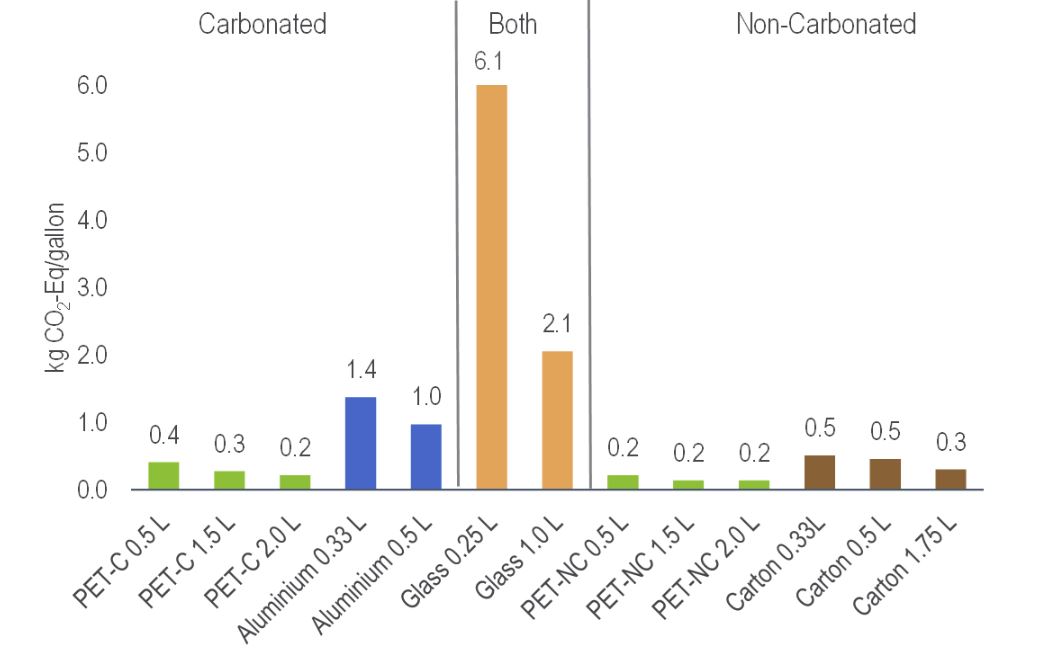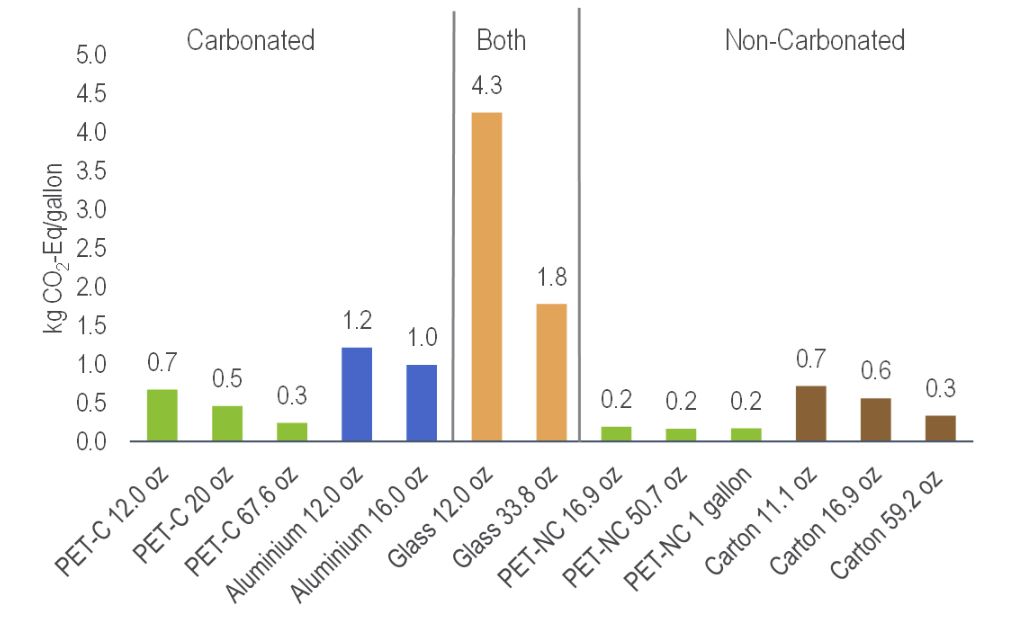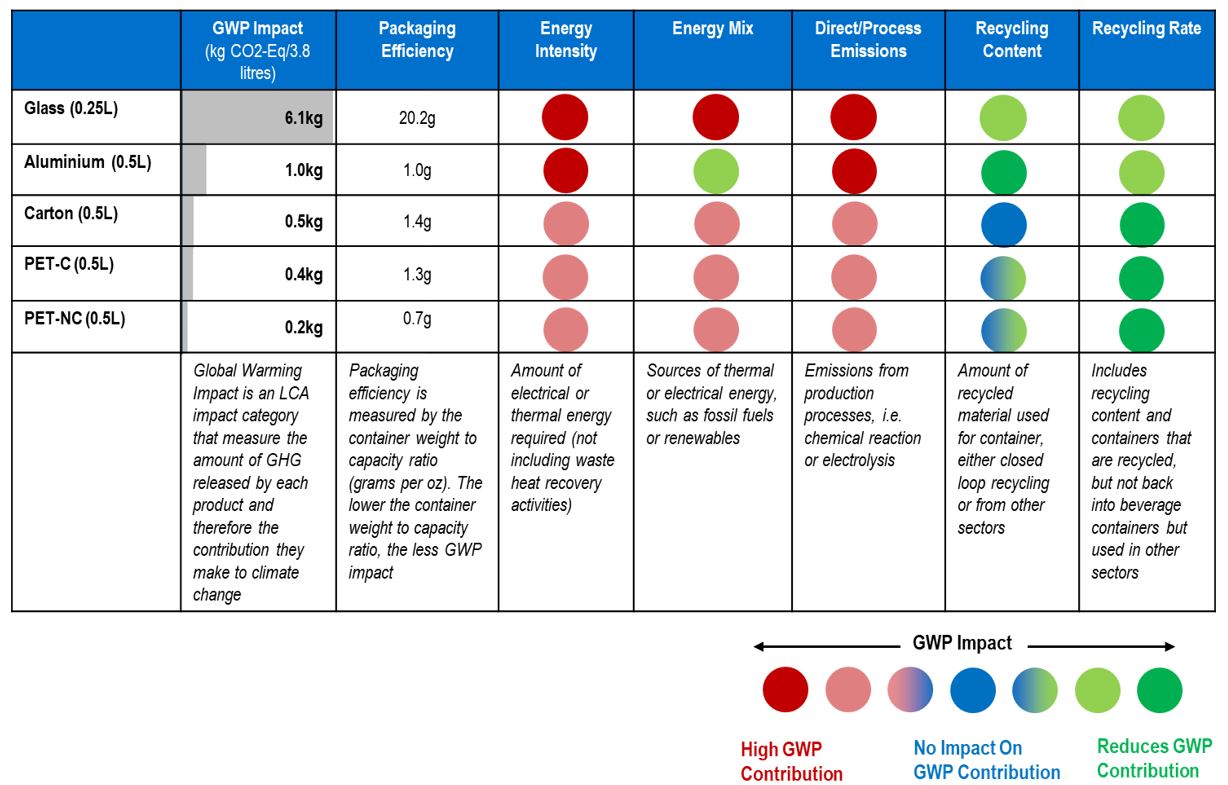LCA analysis assesses the global warming potential of widely used beverage packaging materials

As part of our sustainability initiatives, we recently conducted an evaluation and comparison of the potential environmental impacts of single use beverage packaging materials for carbonated and non-carbonated (water) drinks in Europe and North America for a variety of beverage container sizes.
Download the executive summary of our Consequential Life Cycle Assessment report
The evaluation comprised of a Consequential Life Cycle Assessment (CLCA) to quantify the Global Warming Potential (GWP) and five other key environmental impact indicators (to measure other environmental issues such as human health impact, marine and freshwater ecological impact, soil degradation, water depletion etc.) of each packaging material alternative across its supply chain, comprising a range of commonly used container sizes and the single use packaging materials of polyethylene terephthalate (PET) plastic, aluminium, glass and cartons. Representative assumptions were made at each stage of the supply chain based on current industry practices, including recycling rates and content.
In terms of Global Warming Potential, our evaluation has found that PET offers clear advantages versus beverage packaging alternatives in both regions. This is also reflected across all other impact categories, apart from eutrophication where it had the second lowest impact.
To find ways to reduce their global warming and other environmental impacts, companies all along the packaging/beverage value chain have looked at technical solutions which offer considerable benefits toward sustainability, but often require years before the technology is mature enough to make it commercially and technically viable (renewable power assets, bio-feedstocks, green hydrogen etc.). The analysis highlights that, at least for beverage container and drinks manufacturers as well as for drinks brands, simply changing their packaging material to a lower GWP material, increasing container volumes and designing more lightweight and recyclable beverage containers will significantly reduce their GWP impact without the cost, time and risk associated with some novel sustainable technical solutions.
North American Beverage Packaging Global Warming Potential Impact, per One Gallon of Liquid Fill (Carbonated and Non-Carbonated Beverage Packaging Material)
AL1.JPG
Europe Beverage Packaging Global Warming Potential Impact, per 3.8 Litres of Liquid Fill (Carbonated and Non-Carbonated Beverage Packaging Material)
AL2.JPG
Source: NexantECA analysis
There are a variety of factors that can materially affect beverage containers’ GWP impact (and the other impact categories measured in our analysis). These factors stem from the technical characteristics of each packaging material and its supply chain dynamics including manufacturing routes.
Significance of Key Global Warming Potential (GWP) Activities on European Packaging Materials’ Climate Impact Ranking (Europe)
Significance of Key Global Warming Potential (GWP) Activities on European Packaging Materials’ Climate Impact Ranking
Source: NexantECA analysis
We have categorised these factors into six primary influencers in GWP (and for most impact categories):
Packaging efficiency/lightweighting materially affects the sustainability of the container materials, and in some cases puts a material at such a great advantage/disadvantage that other GWP impactors do little to change its GWP impact ranking. PET non-carbonated water bottles are extremely lightweight. Glass bottles are around 14-20 times heavier than PET bottles for equivalent container size due to lower tensile strength. Although glass has the lowest GWP per kg, its high bottle weight to capacity ratio results in it having the highest GWP impact (in single use applications). The ability to reseal PET bottles and cartons allow for larger beverage containers that can be consumed over longer periods. This ability to ‘upsize’ beverage containers reduces GWP contribution per volume of drink as container weight to capacity ratio decreases, except for PET non-carbonated bottles which were equally efficient for all capacity sizes measure for this project.
Energy intensity is a key GWP contributor. Glass and aluminium are the most energy intensive materials examined, primarily due to the thermal requirements of glass production and the power consumption required for the electrolysis process to convert alumina feedstock into aluminium. Electrical energy is more emission intensive than thermal energy due to the low electrical efficiency in converting chemical power into electrical power (approximately 30-50 percent efficiency) compared to thermal burners that can convert approximately 80-95 percent of chemical energy into useful thermal energy.
Energy mix has a limited impact within the same region, as the beverage packaging materials’ energy mix is generally from the same sources (national power grids or natural gas pipelines), except for aluminium. Aluminium cans do capture benefits in North America and Europe, due to sourcing over 70 percent of its power requirements from hydropower.
Direct emissions include emissions footprint due to chemical reactions during the PET resin manufacturing stage of its value chain. Aluminium is also negatively impacted by this due to the direct emissions emitted from aluminium smelters, specifically from the electrolysis processes, as well as from reheating and melting activities for recycling and can sheet production activities. Cartons have significant direct emissions despite utilising biomass feedstock, due to its reliance on plastic film and aluminium foil which our analysis found constituted roughly 30 percent of the container weight but contributed over 60 percent of its GWP impact.
Recycling content materially reduces GWP impact of aluminium cans and glass, due to their high recycling content from a well developed closed loop recycling system in the examined regions. PET bottles have lower benefits in this category due to a lower recycling content in its bottles. Cartons do not benefit as they cannot be recycled back into cartons. Recycling content for Europe was 0 percent for beverage cartons, 14.5 percent for PET bottles, 60 percent for glass bottles and 72 percent for aluminium cans. For North America it was 0 percent for beverage cartons, 9 percent for PET bottles, 33 percent for glass bottles and 74 percent for aluminium cans. These were taken from independent third party sources for years 2019 or 2020, depending on data availability.
Recycling rate reduces GWP impacts for PET bottles (especially in Europe) where there is a high open loop recycling of PET bottles that are made into carpets and fabrics, thereby reducing the amount of virgin material needed in that sector. Aluminium cans do not benefit as much, due to cans that are recycled in open loop systems often being downgraded (due to mixing different aluminium alloys together), replacing significantly less virgin aluminium material than in closed loop systems. Cartons benefit from this category but since it replaces primarily biomass material, the impact was less pronounced. The recycling rate for Europe was 48 percent for beverage cartons, 46 percent for PET bottles, 74 percent for glass bottles and 76 percent for aluminium cans. For North America it was 18 percent for beverage cartons, 28 percent for PET bottles, 40 percent for glass bottles and 49 percent for aluminium cans. These were taken from independent third party sources for years 2019 or 2020, depending on data availability.
There is no question that single use packaging waste pollution that is leaked into the environment must be tackled rapidly, a view shared by both producers and consumers of packaging materials and governments, exampled by the significant growth in recycling capacities, recycling regulations, recycling policies from FMCG companies and packaging material producers and consumer activism. However, what is equally important is addressing the other environmental sustainability issues, such as climate change, human health etc., which should not be compromised by prioritising one environmental agenda over another.
Our evaluation also reiterates the growing industrial consensus that LCAs are of critical importance in quantifying environmental impact of products and processes, offering more insight than merely certifying GWP performance and highlighting generic environmental ‘hotspots’. In this case, an LCA can offer beverage container and drinks manufacturers/brands the most accurate mechanism to date in determining critical climate change and environmental impact contributors in their supply chain and activity profiles, and therefore an ability to identify and address both manufacturing and supply chain challenges to deliver material improvements in sustainability.
Our CLCA was carried out in compliance with the requirements of ISO 14040 and 14044, including a review panel of three independent LCA professionals with PhDs in the field and led by Dr Shabbir Gheewala, globally ranked by Reuters in 2021 in the top 600 most impactful researcher in the field of climate change. Additionally, we collaborated with Singapore Institute of Manufacturing Technology (SIMTech), A*STAR to support development of the LCA model used for the evaluation.
The executive summary report of this LCA is available to download here
The full LCA report can be requested by email. Please contact: ContactUs@NexantECA.com
The Authors…
Andrew Lindsay, Managing Consultant
Puridej Warakunwit PhD, Consultant


